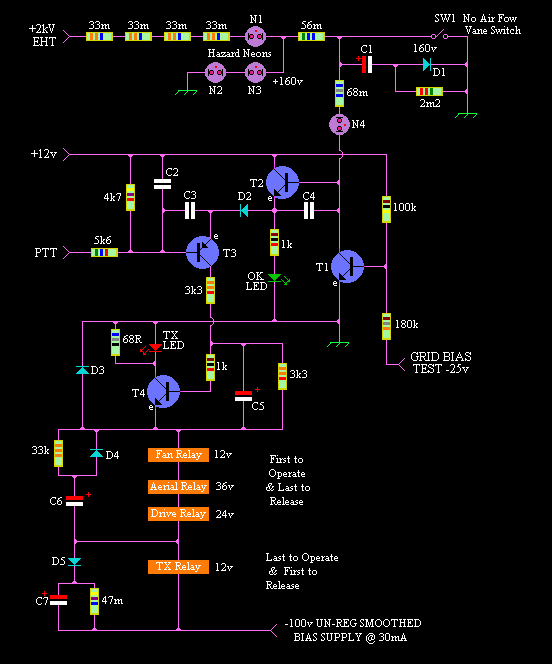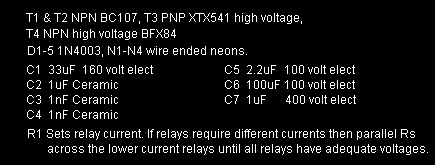The PTT relay should connect the power to the valve to turn the valve on for TX. It is recommended that this relay operates after the aerial C/O relay, but releases before the aerial C/O. Suitable diode steered CRs can do this.
Also note that the screen power (PTT RELAY) should not be connected if the valve...
1/ has No Anode supply,
2/ has no air flow.
3/ has no bias supply.
4/ has not warmed up. (takes 1 min),
5/ has no 12V Control voltage.
MY SOLUTION
Again simple transistor & relay inhibit electronics can do all this (e.g. no PICS or gate arrays). Here is one way I have used for a contest K2RIW 70cm PA. It uses the negative bias supply for the relays as I had some different voltage but similar current relays to power up in sequence.


HOW IT WORKS
Protection.
On power up wire neons N1 N2 N3 are lit from EHT. After the fan pressure vane switch SW1 goes open the 150V across N2+N3, charges up C1 through D1, from the EHT in about 1 min time set my C1 & M56. With the discharge though the 2M2 it also mimics the valve temperature & shortens the warm up time is the valve is already warm. (1 & 2)
If GRID BIAS is OK it opposes the 12V rail & turns off T3, that would otherwise inhibit T1 from being able to turn on. (3)
When the voltage on C1 is > 90V the warm up delay, N4 neon strikes & turns on T1.
This light up the OK LED. (4 & 5)
Timing
On PTT earthing T3 is now able to be turned on, after a small delay to stop to fast a PTT/Rig mic contact bounce & some RFI filtering etc.
T4 turns on NPN emitter follower T4 after more slight delay circuit.
T4 operating immediately powers up the 3 first to operate relays, these prepare the circuits for the PA RF path & valve cooling speed up etc.
When C7 is charged up via steering diode D5, TX relay is operated, putting HT on G2 of the PA.
On PTT unearthing the reverse happens. But this time the TX relay releases first & the now charged up C6 via steering diode D4 holds the FAN AERIAL & DRIVE relays for a fraction of a second.
These features ensure there is no welding/slashing of RF contacts on the relays that is easy to do with QRO PAs, as well as chancing PA stage flashover by powering up the valve into no load or possibly unstable key up/down RF oscillation.